语言学概论期末考试范围
语言学概论期末复习重点
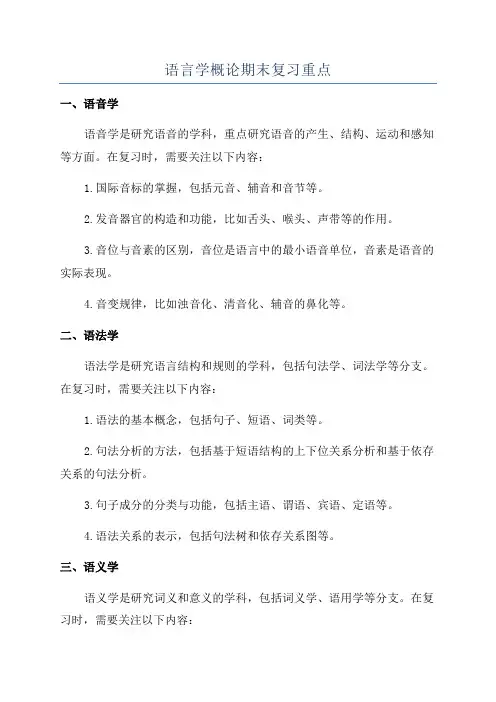
语言学概论期末复习重点一、语音学语音学是研究语音的学科,重点研究语音的产生、结构、运动和感知等方面。
在复习时,需要关注以下内容:1.国际音标的掌握,包括元音、辅音和音节等。
2.发音器官的构造和功能,比如舌头、喉头、声带等的作用。
3.音位与音素的区别,音位是语言中的最小语音单位,音素是语音的实际表现。
4.音变规律,比如浊音化、清音化、辅音的鼻化等。
二、语法学语法学是研究语言结构和规则的学科,包括句法学、词法学等分支。
在复习时,需要关注以下内容:1.语法的基本概念,包括句子、短语、词类等。
2.句法分析的方法,包括基于短语结构的上下位关系分析和基于依存关系的句法分析。
3.句子成分的分类与功能,包括主语、谓语、宾语、定语等。
4.语法关系的表示,包括句法树和依存关系图等。
三、语义学语义学是研究词义和意义的学科,包括词义学、语用学等分支。
在复习时,需要关注以下内容:1.语义的基本概念,包括词义、句义、语篇意义等。
2.词义的分类,包括编码词义和概念词义等。
3.语义关系的表示,包括隐性关系和显性关系等。
4.语义义原的掌握,比如用来描述词义的最小单位,可以用来解释多义、歧义、同义等现象。
四、语用学语用学是研究语言在特定情境中的使用和理解的学科,包括语用规则、言语行为等方面。
1.言语行为的分类,包括表示、指示、陈述、询问等。
2.言语行为的成分,包括言辞、语境、意图等。
3.语用规则的掌握,比如礼貌原则、言外之意等。
4.言语行为的实现方式,包括直接言语行为和间接言语行为等。
以上仅为语言学概论期末复习的一些重点内容,学生可以结合教材和课堂笔记进行更深入的学习和理解。
此外,复习时可以参考相关的案例和实例,加深对语言学原理的理解和应用。
《语言学概论》 期末检测试题3套含答案(大学期末复习资料).doc
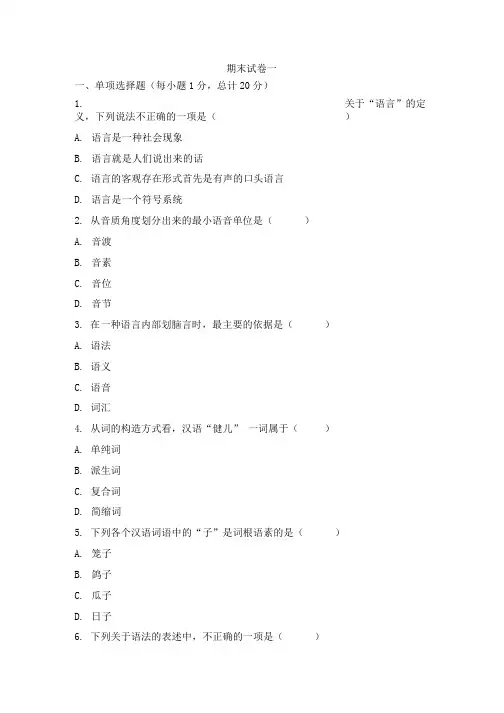
期末试卷一一、单项选择题(每小题1分,总计20分)1.关于“语言”的定义,下列说法不正确的一项是()A.语言是一种社会现象B.语言就是人们说出来的话C.语言的客观存在形式首先是有声的口头语言D.语言是一个符号系统2.从音质角度划分出来的最小语音单位是()A.音渡B.音素C.音位D.音节3.在一种语言内部划脑言时,最主要的依据是()A.语法B.语义C.语音D.词汇4.从词的构造方式看,汉语“健儿” 一词属于()A.单纯词B.派生词C.复合词D.简缩词5.下列各个汉语词语中的“子”是词根语素的是()A.笼子B.鸽子C.瓜子D.日子6.下列关于语法的表述中,不正确的一项是()A.语法是关于词的构成变化和词构成词组和句子的规则B.语法是说本族语的人的直觉知识和约定习惯C.语法是与语音、语汇等要素互不相关的规则D.语法是与语音、语汇等相比变化较慢的现象7.下列关于词义模糊性的表述中,正确的一项是()A.词义所指范围边缘区域模糊,中心区域明确B.词义所指范围边缘区域明确,中心区域模糊C.词义所指范围边缘区域、中心区域都模糊D.词义所指范围边缘区域可能模糊8.“哈巴狗”和“狮子狗”指的是同一种狗,二者在词义上的主要差别是()A.理性意义不同B.语体色彩不同C.形象色彩不同D.语气意义不同9.下列各项中,含有降级述谓结构的是()A.他申请去北京进修B.你去请他比较好C.他取下了挂在墙上的地图D.他害怕老师批评他10.下列各项中,甲和乙之间是预设关系的是()A.(甲)他有一件西服(乙)他有一件衣服B.(甲)他的西服破了(乙)他有一件西服C.(甲)那个学生借给他一本《红楼梦》一一(乙)那个人借给他一本《红楼梦》D.(甲)那个学生借给他一本《红楼梦》一一(乙)那个学生借给他一本书11.1956年我国推行汉字简化方案,将繁体字改成简体字,这属于()A.正字法改革B.字符类型改革C.文字类型改革D.字符类型和文字类型改革12.汉语中的“基因”来自英语的gene,从该词产生的方式看,“基因”属于(A.纯粹音译词B.音译兼意译词C.意译词D.仿译词13.从语言的发展演变来看,语汇系统中最不易发生变化的是()A.通用语汇B.常用语汇C.基本语汇D.专用语汇14.关于社会方言的形成,下列说法不正确的一项是()A.社会方言大多是在语言的相互接触中形成的B.社会方言是随着社会的社群分化而产生的C.一种语言的内部有可能形成社会方言D.一种方言的内部有可能形成社会方言15.关于共同语的形成,下列说法不正确的一项是()A.并不意味着方言分歧已经消失B.并不意味着方言分歧将会扩大C.并不意味着方言最终将被取代D.并不意味着语言已经实现统一16.关于语言规范化的推行,下列说法不正确的一项是()A.主要由权威机构提出具体的规范意见B.主要由权威机构强制推行C.主要通过教育机构、大众传媒等渠道向社会推行D.主要是一个积极引导社会公众自觉遵守的过程17.关于语言获得的原因,下列学说中偏重于内部条件解释的是()A.模仿说B.天赋说C.强化说D.刺激反应说18.社会语言学属于()A.理论语言学B.广义应用语言学C.普通语言学D.狭义应用语言学19.汉语中的:“了、着、过”在古代具有实实在在的词汇意义,到现代变成只表语义的助词,这属于()A.异化B.类化C.新语法范畴的形成D.实词虚化20.下列语言中属于粘着语的是()A.苗语B.越南语C.俄语D.日语二、多项选择(每个小题3分,共30分)1.根据舌位的高低,元音可分为()A.高兀音B.央元音C.半高元音D.半低元音E.低元音2.下列汉字的读音中多包含有辅音[飞]的有()A.男B.拉C.拿D.拦E.驴3.下列词中带有前缀的是(%1老鼠%1画家%1阿姨%1超越%1超现实主义4.下列词组叫,带双宾语的是()%1托你一件事%1托你办件事%1请你办这件事%1借你五元钱%1给你一本书5.下列语素中,属于枯着语素的是()%1宏%1伟%1大%1楼%1机6.卞列语言单位中,属于派生词的是()%1律师%1鸟儿%1老婆%1苦头%1文学家7.下列词中,处于同一个语义场的词是()%1桌子%1椅子%1沙发%1柜子%1鞋子8.下列语言属于印欧语系的是()%1法语%1英语%1德语%1阿拉伯语%1维吾尔语9.汉语属于()%1汉藏语系%1汉语族%1屈折语%1孤立语%1粘着语10.下列文字中属于表意文字的是()%1汉字%1中美洲的马雅文字%1古埃及的圣书字%1我国纳西族的东巴文%1古印度的法卢文三、判断题(每题2分,共20分)1.符号有视觉符号、听觉和触觉符号三种,语言是一种视觉符号。
语言学概论》期末考试复习题及参考答案
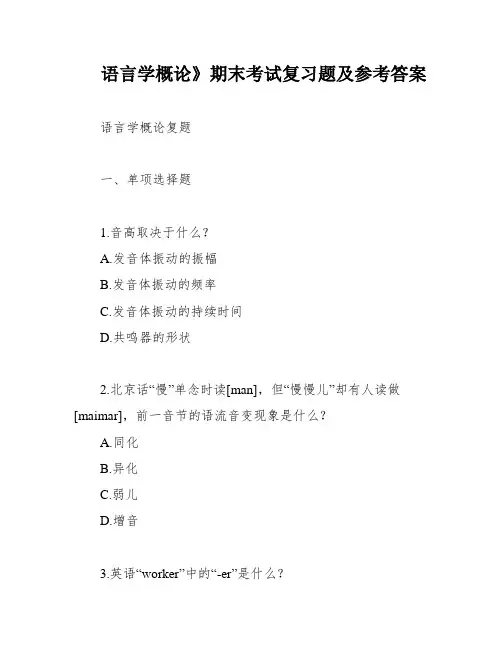
语言学概论》期末考试复习题及参考答案语言学概论复题一、单项选择题1.音高取决于什么?A.发音体振动的振幅B.发音体振动的频率C.发音体振动的持续时间D.共鸣器的形状2.北京话“慢”单念时读[man],但“慢慢儿”却有人读做[maimar],前一音节的语流音变现象是什么?A.同化B.异化C.弱儿D.增音3.英语“worker”中的“-er”是什么?A.构词语素B.构形语素C.虚词语素D.词根语素4.下列汉语词语中的“儿”不属于词根语素(实义语素)的是什么?A.健儿B.女儿C.少儿D.花儿5.“吓唬”和“恐吓”在非理性意义上的主要差别是什么?A.语气意义不同B.感情色彩不同C.语体色彩不同D.形象色彩不同6.“XXX说服了XXX”中“XXX”是行为的施事,“XXX”是行为的受事,这种意义是什么?A.语汇意义B.语法意义C.语境意义D.蕴含意义7.语言成分的借用,最常见、最突出的是什么?A.词语的借用B.语音成分的借用C.词缀的借用D.语法结构的借用8.下列几种类型的社会方言中,具有排他性的是什么?A.行话B.黑话C.官腔D.贵族语言9.下列辅音音素都是XXX的一组是什么?A.[d。
l]B.[b。
k]C.[p。
n]D.[t。
v]10.从语音的社会功能角度划分出来的最小语音单位是什么?A.音位B.音素C.音节D.音渡11.英语“students”中的“-s”是什么?A.虚词语素B.词根语素C.构形语素D.构词语素12.下列现象中不属于词法手段的是什么?A.虚词B.重叠C.轻重音D.词形变化13.下面词组中,结构类型与其他各组不同的一组是什么?A.年轻漂亮/朴素大方B.我们大家/首都北京C.铁路民航/工人农民D.贯彻执行/讨论研究14.下列成对的词语中,属于相对反义词的一组是什么?A.成功—失败B.合法—非法C.本地—外地D.勤劳—懒惰15.造成“北京人多”一句歧义的主要原因是什么?A.一词多义B.不同的句法结构关系C.不同的语义结构关系D.不同的层次构造16.下列关于语言起源的表述中,正确的一项是什么?A.语言产生于人类对外界各种声音的摹仿B.语言产生于人们的相互约定C.语言是人类有意识地在短时间内创造出来的D.语言是人类在长期进化发展过程中创造出来的17.在儿童学会说话的过程中,“双词阶段”标志着儿童已经具备了语法能力,能够组合两个词来表达意思。
2020年电大语言学概论期末复习考试必考重点【精心编辑可直接打印】
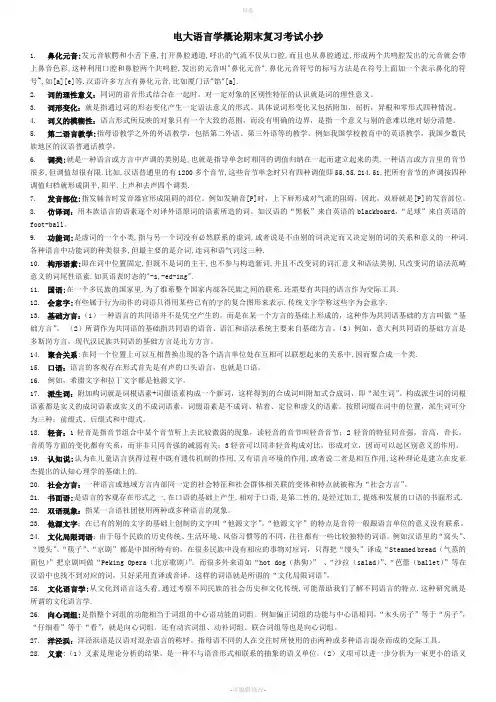
电大语言学概论期末复习考试小抄1.鼻化元音:发元音软腭和小舌下垂,打开鼻腔通道,呼出的气流不仅从口腔,而且也从鼻腔通过,形成两个共鸣腔发出的元音就会带上鼻音色彩,这种利用口腔和鼻腔两个共鸣腔,发出的元音叫"鼻化元音".鼻化元音符号的标写方法是在符号上面加一个表示鼻化的符号~,如[a][e]等.汉语许多方言有鼻化元音,比如厦门话"馅"[a].2.词的理性意义:同词的语音形式结合在一起时,对一定对象的区别性特征的认识就是词的理性意义。
3.词形变化:就是指通过词的形态变化产生一定语法意义的形式。
具体说词形变化又包括附加,屈折,异根和零形式四种情况。
4.词义的模糊性:语言形式所反映的对象只有一个大致的范围,而没有明确的边界,是指一个意义与别的意难以绝对划分清楚。
5.第二语言教学:指母语教学之外的外语教学,包括第二外语、第三外语等的教学。
例如我国学校教育中的英语教学,我国少数民族地区的汉语普通话教学。
6.调类:就是一种语言或方言中声调的类别是,也就是指导单念时相同的调值归纳在一起而建立起来的类.一种语言或方言里的音节很多,但调值却很有限.比如,汉语普通里的有1200多个音节,这些音节单念时只有四种调值即55.35.214.51,把所有音节的声调按四种调值归档就形成阴平,阳平,上声和去声四个调类.7.发音部位:指发辅音时发音器官形成阻碍的部位。
例如发辅音[P]时,上下唇形成对气流的阻碍,因此,双唇就是[P]的发音部位。
8.仿译词:用本族语言的语素逐个对译外语原词的语素所造的词。
如汉语的“黑板”来自英语的blackboard,“足球”来自英语的foot-ball。
9.功能词:是虚词的一个小类,指与另一个词没有必然联系的虚词,或者说是不由别的词决定而又决定别的词的关系和意义的一种词.各种语言中功能词的种类很多,但最主要的是介词,连词和语气词这三种.10.构形语素:即在词中位置固定,但既不是词的主干,也不参与构造新词,并且不改变词的词汇意义和语法类别,只改变词的语法范畴意义的词尾性语素.如英语表时态的"-s,-ed-ing".11.国语:在一个多民族的国家里,为了维系整个国家内部各民族之间的联系,还需要有共同的语言作为交际工具.12.会意字:有些属于行为动作的词语只得用某些已有的字的复合图形来表示.传统文字学称这些字为会意字.13.基础方言:(1)一种语言的共同语并不是凭空产生的,而是在某一个方言的基础上形成的,这种作为共同语基础的方言叫做“基础方言”。
语言学概论考试重点
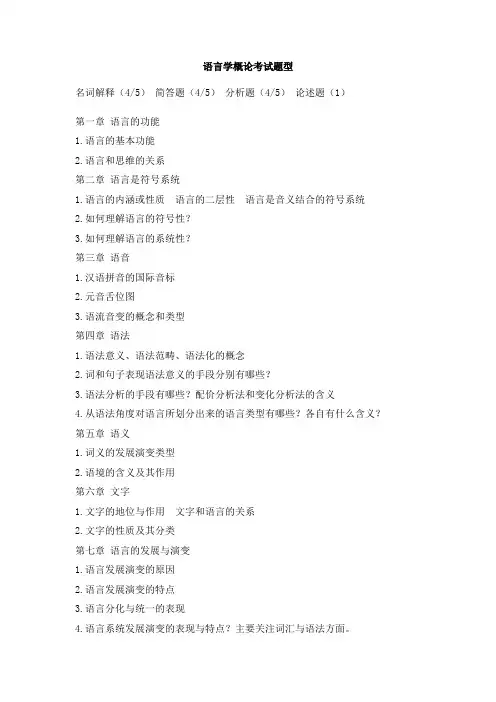
语言学概论考试题型
名词解释(4/5)简答题(4/5)分析题(4/5)论述题(1)
第一章语言的功能
1.语言的基本功能
2.语言和思维的关系
第二章语言是符号系统
1.语言的内涵或性质语言的二层性语言是音义结合的符号系统
2.如何理解语言的符号性?
3.如何理解语言的系统性?
第三章语音
1.汉语拼音的国际音标
2.元音舌位图
3.语流音变的概念和类型
第四章语法
1.语法意义、语法范畴、语法化的概念
2.词和句子表现语法意义的手段分别有哪些?
3.语法分析的手段有哪些?配价分析法和变化分析法的含义
4.从语法角度对语言所划分出来的语言类型有哪些?各自有什么含义?第五章语义
1.词义的发展演变类型
2.语境的含义及其作用
第六章文字
1.文字的地位与作用文字和语言的关系
2.文字的性质及其分类
第七章语言的发展与演变
1.语言发展演变的原因
2.语言发展演变的特点
3.语言分化与统一的表现
4.语言系统发展演变的表现与特点?主要关注词汇与语法方面。
语言学概论期末复习资料整理
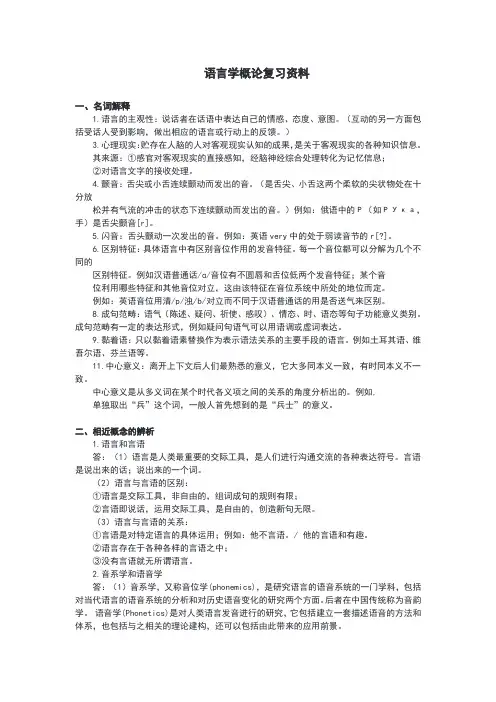
语言学概论复习资料一、名词解释1.语言的主观性:说话者在话语中表达自己的情感、态度、意图。
(互动的另一方面包括受话人受到影响,做出相应的语言或行动上的反馈。
)3.心理现实:贮存在人脑的人对客观现实认知的成果,是关于客观现实的各种知识信息。
其来源:①感官对客观现实的直接感知,经脑神经综合处理转化为记忆信息;②对语言文字的接收处理。
4.颤音:舌尖或小舌连续颤动而发出的音。
(是舌尖、小舌这两个柔软的尖状物处在十分放松并有气流的冲击的状态下连续颤动而发出的音。
)例如:俄语中的Р(如РУка,手)是舌尖颤音[r]。
5.闪音:舌头颤动一次发出的音。
例如:英语very中的处于弱读音节的r[?]。
6.区别特征:具体语言中有区别音位作用的发音特征。
每一个音位都可以分解为几个不同的区别特征。
例如汉语普通话/ɑ/音位有不圆唇和舌位低两个发音特征;某个音位利用哪些特征和其他音位对立,这由该特征在音位系统中所处的地位而定。
例如:英语音位用清/p/浊/b/对立而不同于汉语普通话的用是否送气来区别。
8.成句范畴:语气(陈述、疑问、祈使、感叹)、情态、时、语态等句子功能意义类别。
成句范畴有一定的表达形式,例如疑问句语气可以用语调或虚词表达。
9.黏着语:只以黏着语素替换作为表示语法关系的主要手段的语言。
例如土耳其语、维吾尔语、芬兰语等。
11.中心意义:离开上下文后人们最熟悉的意义,它大多同本义一致,有时同本义不一致。
中心意义是从多义词在某个时代各义项之间的关系的角度分析出的。
例如,单独取出“兵”这个词,一般人首先想到的是“兵士”的意义。
二、相近概念的辨析1.语言和言语答:(1)语言是人类最重要的交际工具,是人们进行沟通交流的各种表达符号。
言语是说出来的话;说出来的一个词。
(2)语言与言语的区别:①语言是交际工具,非自由的,组词成句的规则有限;②言语即说话,运用交际工具,是自由的,创造新句无限。
(3)语言与言语的关系:①言语是对特定语言的具体运用;例如:他不言语。
语言学概论期末考试试卷与答案
语言学概论期末考试试卷一、填空题(每空1分,共15分)1、语言符号的形式是表达一定内容的声音,语言符号的内容是语义。
2、音素可以分为元音和辅音两大类。
3、传统语法学把语法分成两种规则,即词法和句法;现代语法学把语法分成两个层面,即核心语法和外围语法。
4、世界上保存下来比较完整的三种最古老的文字,即距今五千多年前出现的古埃及文字和苏美尔文字以及距今三千四百年左右的中国的甲骨文。
5、研究语言的心理机制和相关表现的学科叫做心理语言学。
6、语言在思维认知活动中的作用主要表现为三个方面,一是语言可以帮助完成人的认知过程,二是语言可以储存人的认知成果,三是语言可以改造人的认知能力。
二、单项选择题(每小题1分,共10分)1、音高主要决定于( B )A.发音体振动的振幅 B.发音体振动的频率C.发音体振动的时间 D.发音体振动的声波形式2、最小的有意义的能独立使用的语言单位是( B )A.语素 B.词 C.词组 D.句子3、“的”字词组相当于( A )A.名词的词组 B.动词的词组 C.形容词的词组 D.介词词组4、人们在反映现实现象的同时,还可能表现出对该现象的主观态度,从而在词的理性意义上增添了一层附加色彩,这种色彩是(A )A.感情色彩 B.语体色彩 C.形象色彩 D.音响色彩5、有的述谓结构的变元本身是一个述谓结构,这种充当其他谓词变元的述谓结构就是( C )A.简单述谓结构B.复合述谓结构C.从属述谓结构D.降级述谓结构6、阿拉伯文字是( A )A.辅音文字 B.音节文字 C.表意文字 D.意音文字7、语言是一种( B )A.心理现象 B.社会现象 C.物理现象 D.生理现象8、语素分类中最大的类是( C )A.语族 B.语支 C.语系 D.语群9、下列词语中属于借词的是( A )A.摩登 B.妯娌 C.把戏 D.马虎10、语言是思维的工具指的是( B )A.一切思维必须由语言完成B.主要指抽象思维和其他思维高级阶段离不开语言C.主要指感性思维和发散思维离不开语言D.先有语言后有思维三、名词解释(每小题4分,共16分)1、音位2、组合规则3、语法手段4、抽象思维四、简答题(每小题7分,共21分)1、人类语言的起源必须具备哪三方面的条件?1、答:首先,人类的思维能力要发展到一定的水平,应该能够对客观世界的事物进行分类和概括,并具有一定的记忆和想象、判断和推理的能力,只有具备了这样的心理条件才有可能产生语言。
语言学概论期末考试试卷(参考答案)
语言学概论期末考试试卷(参考答案)语言学概论期末考试试卷一、填空题(每空1分,共15分)1、现代语言学之父是,他的代表作是。
2、美国语言学家创立了高度形式化的生成语法。
3、人耳能听到的声音频率范围在赫兹之间。
低于赫兹的声音叫“次声”,高于赫兹的声音叫“超声”。
4、本书讨论的语汇学主要包括两个方面的内容:一是,二是。
5、语法是语言中关于词的和词的规则。
6、各种文字的字符大体上可以归纳成三大类,即、和。
7、文字起源于和。
二、单项选择题(每小题1分,共10分)1、人类最重要的交际工具是()A.文字B.语音C.语言D.手势、表情等非言语手段2、语言是()A.写成的作品或发表的言论B.个人说的行为和结果C.从言语中概括出来的为社会所公认的词语和规则的总和D.说话3、应用语言学最早是指()A.计算语言学B.语言教学C.交际语言学D.心理语言学4、汉语普通话的辅音音位[ ]的区别特征是()A.舌叶清擦音B.舌面中浊擦音C.舌面前清擦音D.舌面后清擦音5、“拼死拼活”和“风风火火”是()A.成语B.惯用语C.歇后语D.谚语6、“所以”是一个()A.词B.词组C.句子D.语素7、词类的本质属性是()A.形态B.意义C.分布D.结构8、由语法形式表达的语义叫做()A.理性意义B.非理性意义C.词汇意义D.语法意义9、下面几个词语具有贬义色彩的是()A.成果B.勾结C.顽强D.鼓励10、在述谓结构中()是处于支配地位的核心成分A.情态B.命题C.谓词D.变元三、名词解释(每小题4分,共16分)1、能指2、韵律特征3、向心词组4、语系四、简答题(每小题7分,共21分)1、义素分析的步骤2、为什么说语言学理论和应用研究应该区分?3、划分词类有哪些标准?五、分析题(每小题8分,共16分)1、在[ ]里写出相应的音标,在()里写出包含这个音的例子(语种不限)。
如:舌尖中不送气浊塞音:[d](英:dog狗)(1)舌根浊鼻音:[ ]、()(2)舌尖前不送气清塞擦音:[ ]、()(3)舌面后清擦音:[ ]、()(4)舌尖后送气清塞擦音:[ ]、()(5)双唇不送气浊塞音:[ ]、()(6)唇齿浊擦音:[ ]、()2、下面几组英语片段中的划线部分都是通过一定语法手段表示了不同的语法意义,属什么语法范畴,以及采用了什么语法手段。
语言学概论期末试题
汉语规范化17个名词解释5个综合应用14个简答题一、名词解释:1.语流音变:音位和音位组合的时候,或者由于受临近音的影响,或者由于说话快慢、高低、强弱的不同,可能发生不同的变化,这种变化叫做语流音变,常见的语流音变有同化、异化、弱化和脱落四种。
2.仿译词:用本族语的构词材料逐一翻译原词的语素,不仅把意义,而且把内部构成形式也移植过来的词,如黑板。
3.亲属语言:从同一种语言分化出来的几种独立的语言,彼此有同源关系,这几种语言就是亲属语言。
如汉语和藏语来自史前的原始汉藏语,它们同出一源,是亲属语言。
4.对立关系:音素之间的对立关系是指不同的音素可以出现在相同的语音环境里,它们的差别能区别词的语音形式和意义。
5.语言联盟:也称“语言的区域分类”,它是指一片地理区域内的不同语言不仅在词汇上相互有大量的借贷,而且在语音、语法系统的结构格局、结构规则方面也十分相似,但各语言仍有相当数量的核心词根彼此不同。
6.双语(多语)现象:指被融合民族的成员一般会讲两种语言:本族语和在融合中占优势的那种语言。
双语现象的出现是融合过程中的重要的、富有特征性的现象,是两种或几种语言统一为一种语言的必经的过渡阶段。
7.音位的自由变体:指处于同一位置中的几个音素相互可以自由替换,没有条件限制,这样的音素就是同一音位的自由变体。
8.对立关系:音素之间的对立关系是指不同的音素可以出现在相同的语音环境里,它们的差别能区别词的语音形式和意义。
9.句法多义:同一个句式所表示的几种不同的结构意义,叫句法多义。
10.语言符号的任意性:指语言的声音形式和意义内容的联系是任意性的,由社会成员约定俗成,音义之间,没有必然的本质的联系。
这种音义的任意性关系又叫约定性。
例如表示“大”这样意义,汉语用语音[tA]表示,英语用语音[big]表示。
11.类推作用:又叫做“类化”,语法中有齐整划一的趋势和抗拒这种趋势的矛盾,前者是语法演变中经常起作用的力量,叫做“类推作用”。
《语言学概论》课程考核大纲
《语言学概论》课程考核大纲【考核目的】考查学生通过本课程的学习是否能够比较系统地掌握语言学的基本概念、基本理论和基础知识,了解教学效果,从而为提高语言理论水平、进一步学习和深入研究其他语言课程奠定必要的语言理论基础。
【考核范围】考核问题包括语言的社会功能、语言的符号系统、语音、语法、词义、文字和书面语、语言随着社会的发展而发展、语言的接触、语言系统的发展等学科内容。
【考核方法】期末闭卷笔试,占60%;平时(出勤、提问、作业等)占40%。
【期末考试形式】采用笔试、闭卷。
【期末考试对试题的要求】题型比例:主观试题的比例30%,客观试题的比例70%。
难度等级:中等难度【期末考试的具体内容】导言知识点:1.语言学的分类2.语言学的对象和任务3.语言学主要流派介绍考核目标:1.识记:(1)普通语言学(2)共时语言学(3)语文学2.理解:(1)语言学的对象(2)语言学主要流派3.运用:什么是语言学第一章语言的社会功能知识点:1.语言和说话 2.语言是人类最重要的交际工具。
3.语言和思维的关系考核目标:1.识记:(1)语言(2)说话(3)交际工具2.理解:(1)语言的社会功能(2)语言和思维的关系3.运用:为什么说语言是人类特有的、最重要的交际工具第二章语言是符号系统知识点:1.语言符号的性质和特点2.语言符号的系统性3.组合关系和聚合关系考核目标:1.识记:(1)符号(2)任意性(3)任意性2.理解:(1)组合关系(2)聚合关系(3)3.运用:(1)符号尤其是语言符号应该具备的条件(2)语言的组合关系与聚合关系第三章语音知识点:1.语音的基础知识2.音素和音位。
3.语音四要素4.元音和辅音5.对立和互补6.音位和音位变体考核目标:1. 识记:(1)语音(2)音素(3)音位(4)元音(5)辅音(6)音节(7)语流音变2.理解:(1)汉语音节特点(2)音位的区别特征3.运用:(1)元音与辅音的区别(2)什么是音位和音位的变体,什么是自由变体和条件变体,如何确定条件变体第四章语法知识点:1.语法单位2.常见的语法范畴3.主要语法手段4.语言的结构类型;考核目标:1.识记:(1):句子(2)词组(3)词(4)语素(5)性(6)数(7)体(8)时(9)人称2.理解:(1)组合的层次性(2)词形变化(3)划分词类的标准3.运用:(1)分析语言单位的结构层次(2)什么是变换;如何通过变换分析句法多义第五章词义知识点:1.基本词汇及其特点;2.词义与词义的特点;3.词的多义性4.词义派生的途径考核目标:1.识记:(1)词汇(2)词义(3)语素义2.理解:(1)词义类型(2)词义的概括性(3)词义派生的途径3.运用:(1)词语的搭配(2)“言内意外”和词义的组合与运用第六章文字和书面语知识点:1.文字及其作用2.文字与语言的关系3.文字的起源4.口语和书面语考核目标:1.识记:(1)文字(2)表意文字(3)书面语2.理解:(1)文字与语言的关系(2)口语和书面语3.运用:文字的作用第七章语言随着社会的发展而发展知识点:1.语言发展的原因和特点2.社会方言与地域方言3.亲属语言和语言的谱系分类4.共同语及其形成;5.共同语的规范;考核目标:1.识记:(1)共同语(2)社会方言(3)地域方言(4)亲属语言1.理解:(1)语言发展的原因和特点(2)亲属语言和语言的谱系分类3.运用:如何区分地域方言和亲属语言第八章语言的接触知识点:1.语言成分的借用和吸收2.语言融合的原因3.语言的接触考核目标:1.识记:(1)借词(2)意译词2.理解:(1)结构规则的借用(2)洋泾浜(3)克里奥尔3.运用:(1)语言的接触表现在哪些方面(2)语言融合的原因是什么第九章语言系统的发展知识点:1.语音演变的规律性;2.语法发展的表现3.词义演变的方式、途径和结果考核目标:1.识记:(1)历史比较法(2)词语的替换2.理解:(1)词义演变的方式、途径和结果(2)旧词的消亡(3)词义的演变3.运用:(1)新词产生的途径(2)语法的发展表现在哪些方面【样题】一.词解释(每小题2分,共10分)1.音位的自由变体:2.基本词汇:3.音节:4.符号:5.句子:二.填空题(每空1分,共10分)1.结构主义语言学派可以分为三派,它们是布拉格学派、哥本哈根学派和。
- 1、下载文档前请自行甄别文档内容的完整性,平台不提供额外的编辑、内容补充、找答案等附加服务。
- 2、"仅部分预览"的文档,不可在线预览部分如存在完整性等问题,可反馈申请退款(可完整预览的文档不适用该条件!)。
- 3、如文档侵犯您的权益,请联系客服反馈,我们会尽快为您处理(人工客服工作时间:9:00-18:30)。
语言学概论期末复习1. diachronic linguisticsLinguistics that studies language over a period of time, also known as historical linguistics, study of the Chinese language since the end of the Qing dynasty up to the present.2. arbitrarinessLanguage is arbitrary for the forms of linguistic signs bear no natural resemblance to their meaning. The link between the linguistic signs and their meanings is a matter of convention, and conventions differ radically across languages.3. langueAccording to Saussure, langue refers to the abstract linguistic systems shared by all the members of a speech community. It can be thought of as the generalized rules of the language that members of a speech community seem to abide by.4. competenceChomsky defines competence as the abstract ideal user's knowledge of the rules of his language. According to him, anyone who knows a language has internalized a set of rules about the sequences permitted in his language. This internalized set of rules is termed as a person's competence.5. morphemeThe most basic element of meaning is traditionally called morpheme. The “morpheme' is the smallest unit in terms of relationship between expression and content, a unit which can not be divided without destroying or drastically altering the meaning.6. MorphologyMorphology studies morphemes and their different forms and the way they combine in word formation. So it refers to the study of the internal structure of words and the rules by which words are formed7. Semantic triangleAccording to Ogden and Richard's semantic triangle, there is no direct link between language and the world, or between the symbol ( the linguistic elements, the word, the sentence) and referent ( the object in the world of experience). The link is via thought or reference, the concepts of our minds.8. Lingua francaLingua franca is the general term for a language that serves as a means of communication between different groups of speakers.9. componential analysisComponential analysis is a way to analyze lexical meaning, and it defines the meaning of a lexical element in terms of semantic components.10. Cooperative PrincipleCooperative Principle (CP) was proposed by Paul Grice, under which there are four maxims: the maxim of quantity, the maxim of quality, the maxim of relation and themaxim of manner. It means in communication, both parties involved will normally seek to cooperate with each other to establish agreed meaning.11. acquisitionThe term “acquisition”is used to refer to picking up a language through exposure. Itrefers to the subconscious or conscious processes. It is learned in a natural or a tutored settings.12. interlanguageIt refers to the learner's independent system of the second language which is neither the native language nor the second language, but a continuum or approximation from native language to the target language.I.Students should be able to answer the following questions:1) Explain the three kinds of intersentential sematic relations: entailment, presupposition and implicature.Entailment is a relation of inclusion , If X entails Y, then the meaning of X is included in Y.. X: I have been to Shanghai. Y: I have been to Chinaif x is true, then y is also true, If Y is false, then X is also X entails Y.X presupposes Y. ( Y is a pre-requisite of X).X: John's brother has got married. Y: John has a brother.Implicature: The speaker may use implied meaning but not the literal meaning.2)According to Austin, what are the three acts a person is possibly performing while making an utterance Give an example.According to Austin, a speaker might be performing three acts simultaneously when speaking. They are locutionary act, illocutionary act and perlocutionary act. For example: You have left the door wide open.The locutionary act performed by the speaker is his utterance of all the words. “you”, “have”, “door”, “open”, etc. thus expressing what the words literally mean.The illocutionary act performed by the speaker is that by ,asking such anutterance he has expressed his intention of speaking, that is , asking someone to close the door, or making a complaint, depending on the context.The perlocutionary act refers to the effect of the utterance . If the then hearergets the speaker's message and sees that the speaker means to tell him to close the door, then the speaker goes to close the door for the speaker.3) What are the major differences between acquisition and language learningRod (1985) and Krashen (1981) regard acquisition as the spontaneous internalization of rules and formulas. The term acquisition is often used to refer to first language acquisition and second language acquisition. First language acquisition is also called mother tongue acquisition.Acquisition takes place in the speech community where one's first language orTheform. on focus much without natural, often is It spoken. is language secondlearning of English by speakers of other languages in the United States is an example of second language acquisition.Foreign language learning usually takes place in the speech community whereone's first language is spoken. It is a conscious process through formal school-like settings and requires time for processing, with focus on linguistic form in addition to knowledge of the rules of language use. For example, the learning of English in China.4) What are the similarities and differences between Semantics and Pragmatics Semantics focuses on the meaning that comes from linguistic knowledge without considering the context. Pragmatics studies the meaning in a certain context taking our knowledge about the physical and social world into account. Semantic analysis look for rules which are black and white, . you are either right or wrong. Pragmatic analysis look for principles. You can obey them to some extent and violate them to some extent.5) Why do we say Language is a system of arbitrary vocal symbols used for human communication Explain it in details.a. Language is systematic. Language must be a system since elements in the language are arranged according to certain rules. Each human language is organized into two basic systems: a system of sounds and a system of meanings.b. Language is symbolic. People use signs to communicate, which means that language involves signs.c. Language is arbitrary. Language is arbitrary for the forms of linguistic signs bear no natural resemblance to their meaning.d. Language is primarily vocal. Language is vocal because the primary medium is sound for all languages, no matter how well developed their writing systems.e. Language is human specific. There are certain characteristics of human language that are not found in the communication systems of any other species.f. Language is used for communication.6) What is the Sapir –Whorf hypothesisThe hypothesis assumes that people's habitual thought patterns and ways of perceiving the world are conditioned to a certain extent by the categories and distinctions that are available to them in their native language. Speakers of different languages may therefore have rather different world-views, depending on how different the languages are from one another semantically and grammatically.Sapir-Whorf hypothesis can be broken down into two basic principles: Linguistic Determinism and Linguistic Relativity.II.Students should be able to draw the tree diagrams for common simple sentences and complex sentences.III.Students should be able to analyze the formation of words.IV.Students should be able to identify errors in given sentences and be able to explain the causes for errors.1. He speaked to Tom yesterday.This intralingual error is due to the overgeneralization of the rule about the English verb's past tense form.2. There were some people came to watch the football match.The relative pronoun at the beginning of the attributive clause is missing. The learner has made an inter-lingual error because of the influence of his mother tongue, that is the Chinese grammatical pattern.3. They are loving basketball very much.This sentence should be corrected as: They love basketball very much. The learner has made an intra-lingual error caused by the over-generation of the target language grammatical rule. The learner failed to realize that in English some verbs never appear in the continuous tense including the verb: love.。
